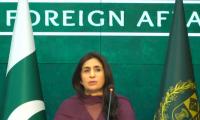The budget announced for FY 2021-22 by the PTI government has been widely welcomed in some circles as a budget designed for Pakistan, and geared at helping its people.
The decision to avoid any major increase in indirect taxation, in taxation on salaried persons, the increase in the minimum wage putting it now at Rs20,000 and the relief offered under the Ehsaas programme as well as a focus on developing agriculture and infrastructure have been cited as some of the reasons for this.
This is all of course relevant and encouraging. But we need to ask a few questions. If Pakistan is to progress, the only way to achieve this is by educating its people. The lack of education is a factor in the large-scale unemployment we continue to see. It is also a factor in the belief in the fake news stories that go around from time to time, even in the unwillingness of other countries to invest in Pakistan given the untrained, illiterate labour force compared to countries like Malaysia or even Bangladesh which can offer an educated but still cheap set of workers and a situation which handicaps people from seeking out opportunity and making progress in life.
The poor quality of primary and secondary education, both at government schools and many private schools, is a factor in this. It also impacts people deciding to keep children away from school, with our dropout rate after primary level still ranked at almost 50 percent, amongst the highest in the world. Corporal punishment, teacher absenteeism, poor teaching standards and other factors have led NGOs to note a situation where children in grade five are unable to read even a single sentence in either English or Urdu unless they have learnt it by rote, or to carry out simple addition problems and other mathematical tasks.
This should compel the government to spend more on education, and on education at the grassroots level rather than the higher education level. While the education budget for this year has been marginally increased to Rs91 billion, a distinct rise from the number over the previous few years, there should be some consideration for the fact that the very few pupils who pursue education at college and university level can hardly be expected to produce work of any quality unless they have a solid foundation on which to move forward.
Without far better teaching in the lowest grades, they cannot hope to compete with the world. Yet, this year we have allocated Rs78 billion to higher education. According to budget documents, only Rs3 billion is available for primary education and Rs7 billion for secondary education. The jump is immense, and we wonder how authorities expect children who receive an extremely poor education to suddenly raise standards as they move into tertiary learning stages.
There is a lot wrong with the structure. The pyramid needs to be reversed so that schoolchildren can be imparted a far better and meaningful learning, and by offering them this kept in schools for far longer than is currently the case. Even those who complete education till the matric level often struggle to read newspaper stories or the instructions printed on medicine cartons and bottles.
Pakistan has paid dearly over the years for its failure to invest in education. While Bangladesh, which took its place on the world’s map as a separate country only in 1971 following a long and draining civil war, today has a literacy rate officially stated at almost 75 percent, Pakistan’s literacy rate officially stands at 59 percent. Bangladesh has a far better female-to-male ratio as far as education goes. Seventy-one percent of Bangladeshi girls and women are literate, compared to 47 percent in Pakistan. The gap is strikingly smaller in Bangladesh, which through giant organisations focused much of its energy on uplifting its population and notably its female population which was prioritized by microcredit and other facilities. The effort appears to have paid off.
At some stage, Pakistan will need to make a similar effort. Global studies have found that educating girls can be crucial to improving the lives of families, since educated mothers are more able to play a part in household decision-making, and often choose in favour of ensuring schooling for children and spending more on better nutrition, better healthcare and other factors which can improve the quality of life for their families.
There are also other factors to consider. The education failures of Pakistan are linked to the poverty of people to at least some degree. High inflation rates, which currently stand at 10 percent overall and 15 percent in May this year for food goods, put inflation in the country at far higher levels than those for either India or Bangladesh. This is obviously terrible news for the people, who must struggle desperately simply to put food on the table. When food is not available, education falls far lower down the priority list of families.
In the latest budget, anti-inflationary measures have been promised. But the question is if policies will work, with people stating that they do not believe prices will fall anytime soon. Indeed, even expert analysts have pointed out that some of the price increases, such as that in the cost of sugar, comes as a result of policy decisions and that this vital commodity is unlikely to fall as far as price is concerned anytime in the very near future.
The picture is not an entirely dismal one. There are obvious efforts in the budget to assist families and lift them out of complete deprivation. But handouts from the Ehsaas Fund will not work alone. Loans to set up small businesses are a somewhat better option, but we need to see how well these schemes work and how they are organized. Again, it is education which remains a key factor in the growth of most countries. Pakistan currently stands towards the very bottom of the list of the world’s nations in terms of literacy. This makes it less likely that it can quickly improve the condition of its people or make it possible for them to move ahead.
Efforts such as the Single National Curriculum cannot improve the standard of education unless it is combined with teacher training and an improvement in the quality of government schools, which often lack electricity, boundary walls, water or even toilets. In this condition, children can hardly be expected to learn and unless children learn there will be too few who are able to move up towards higher learning and into positions where they can help their country develop and grow.
The writer is a freelance columnist and former newspaper editor.
Email: kamilahyat@hotmail.com
A woman walks past a building of the International Monetary Fund. — AFP/FileThe annual and spring meetings of the...
Late Benazir Bhutto's daughter Asifa Bhutto Zardari addresses the Christian community in Bihar Colony on January 23,...
Representational image. — PexelsWater is an important scarce natural resource that is required for several everyday...
Pakistani employees of online marketplace company Kaymu at work in Karachi. — AFP/FileThe true spirit of development...
India uses Afghanistan as a backstage area to carry out terrorist attacks against Pakistan
Another report by the Pakistan Institute of Peace Studies states that 78 per cent of attacks have been carried out by...







